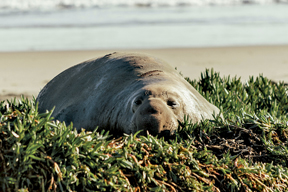
Dear EarthTalk: How were elephant seals saved from extinction? ~ M. Diamandis, Troy, NY
Seals, often referred to as “dogs of the sea” for their notable cuteness, are one of the most prevalent marine mammals in the world, with more than 33 different species currently occupying our land and seas. However, that count was almost lower—until recently.

In the 1700s, nearly all marine mammals, including sea otters, whales, dolphins, seals and sea lions were casualties of the Pacific Northwest fur trade. This included elephant seals, aptly named for their males’ prominent facial appendage. Characterized by their small limb (fin) size, elephant seals spend about 80 percent of their lives underwater and can swim up to 60 miles a day, shielded from the cold by their vast blubber. However, this oil-rich blubber that could be processed into lamp and machine oil was also the reason they were hunted, so near the point of extinction that, by the 1890s, there were less than 100 left.
A small group that managed to survive human threat was discovered off the coast of Mexico in 1892 and was immediately given protected status by the Mexican government, after which they slowly began recovering. By the 1920s, elephant seals were observed off the coast of California, so the U.S placed them under protected status, and the population steadily increased to some 200,000, where it is today.
But their survival did not come without consequence. Researchers have discovered that their near extinction resulted in loss of genetic diversity—meaning that elephant seals’ genetic makeup has been permanently altered. Their research indicated that the species’ severe population decline reduced beneficial genes, increased the risk of inbreeding, and potentially threatened their survival.
“The highly reduced genetic diversity, including the loss of beneficial gene copies, may impair the ability of northern elephant seals to cope with future environmental changes, including those caused by …climate change, changes to the species’ habitat, or even natural threats such as disease outbreaks,” states Professor Kanchon Dasmahapatra of the University of York and senior author of the genetic research.
While elephant seals’ population may be standing strong at over 225,000 today, no aquatic species can escape modern threats like entanglement in fishing gear and collisions with boats, nor human activities like pollution, habitat degradation, and climate change. The remarkable comeback story of elephant seals is a lesson in conservation and ecosystem management from which we can all learn.
MORE INFORMATION: https://www.sciencedaily.com/releases/2024/09/240927173545.htm; https://www.earth.com/news/elephant-seals-have-genetic-scars-from-intense-hunting/.
Dear EarthTalk: Are road salts and other de-icing chemicals bad for the environment? And if, so are greener alternatives available? ~ Jane Willis, Fairfield, IA

Traditional de-icers, particularly chloride-based compounds such as sodium chloride, magnesium chloride and calcium chloride, can have various detrimental effects on the environment. According to the Minnesota Stormwater Manual, chloride-based de-icers contribute to soil degradation by reducing soil permeability and fertility, and by increasing soil alkalinity, which adversely affects plant growth and soil stability. These de-icers contaminate groundwater and surface water, leading to toxic conditions for aquatic life due to elevated salt levels. Vegetation damage is another issue, as chloride exposure causes osmotic stress, leading to damaged roots and foliage. Furthermore, the corrosive nature of these chemicals accelerates the deterioration of infrastructure, including roads, bridges, and vehicles.
Recognizing these issues, there are several greener alternatives to traditional de-icing chemicals. Eco-friendly de-icers, such as those offered by Green Ice Melt, use plant-based ingredients that are biodegradable, have minimal soil and water impact, and are safe for pets. These are also non-corrosive, ensuring that infrastructure remains protected. Non-chloride products, including acetate-based deicers like calcium magnesium acetate and potassium acetate, offer a less corrosive option. However, these can still deplete oxygen water due to their organic content. Carbohydrate-based deicers, derived from beet juice, molasses and corn syrup, have minimal impact and effectively reduce the freezing point ecologically.
Several other techniques can also be employed. Anti-icing, which involves applying salt brine before snowstorms to prevent ice formation and reduce the amount of de-icer needed later. This proactive approach maintains safer conditions with less environmental damage. Pre-wetting salt with brine before application enhances its effectiveness, ensuring that the de-icer adheres better to surfaces and reduces scatter, thereby improving efficiency and minimizing overall usage.
Public awareness campaigns about the benefits of eco-friendly de-icers can also play a significant role in encouraging wider adoption. Furthermore, municipalities and businesses can invest in advanced spreading equipment that ensures precise application, reducing waste and environmental contamination. Encouraging the development and use of new technologies, such as the propylene glycol and aqueous sodium formate mixture developed by Osaka Metropolitan University researchers, can further reduce the environmental footprint of de-icing operation. By making informed choices and embracing sustainable practices, we can ensure safer winter conditions while safeguarding our environment.
MORE INFORMATION: https://stormwater.pca.state.mn.us/; greenicemelt.com/blogs/news/understanding-the-environmental-impact-of-deicers-a-closer-look-with-green-ice-melt.
Dear EarthTalk: Now that we are a few decades into the process of removing dams, how are the fish ecosystems doing? ~ H.F., Boulder, CO
Dams, often built to generate hydroelectric power, store water and control floods, have significant negative impacts. They disrupt natural river flows, fragment habitats and alter the physical, chemical and biological characteristics of their river. When ecosystems are functioning properly, they support a wide variety of plant and animal life, providing crucial benefits to the environment and local communities. A healthy river is marked by clean water, diverse plant and fish life and the ability to transport sediments that replenish beaches and floodplains, all working together sustain life and adapt to ecosystem changes.

As the dam removal process has progressed in the U.S., scientists have seen significant improvements in waterway ecosystems. A long-term study that monitored the Cedar River in Washington state after dam removal showed a remarkable recovery in local fish populations. In the 20 years following the removal of the dam, chinook salmon, coho salmon and mountain whitefish returned to pre-dam population levels. The chinook salmon reached the river’s carrying capacity—the maximum number of fish the river can support. Also, salmon diversity tripled. This demonstrates the long-term benefits of river restoration through dam removal and highlights the potential for ecosystems to recover when natural flow is restored.
In another example, the removal of dams along the Klamath River in California is also helping restore native fish populations. While the deconstruction of the dams initially led to the death of non-native fish species, it paved the way for native fish—like-chinook salmon and steelhead—to migrate upstream for the first time in over 60 years, offering hope that the river will once again become a thriving ecosystem for its native species. According to Bob Pagliuco, a NOAA marine habitat resource specialist, the Klamath River will soon see the return of these iconic fish species to areas where they had been absent for decades.
Dam removal has benefits beyond increased fish populations, allowing for vegetation regrowth, natural sediment transport, better water quality and safe spaces for fish from predators.
Despite these benefits, dam removal remains controversial. But by raising awareness, advocating for policy change and engaging the public through protests, the tide can be turned. Supporting legislation like the Clean Water Act is also crucial. By staying informed and actively participating, we can ensure the long-term health of our rivers and a future with thriving ecosystems and abundant wildlife.
MORE INFORMATION: https://ribbletrust.org.uk/what-do-healthy-rivers-look-like/; https://www.fisheries.noaa.gov/feature-story/worlds-biggest-dam-removal-project-open-420-miles-salmon-habitat-fall
EarthTalk® is produced by Roddy Scheer & Doug Moss for the 501(c)3 nonprofit EarthTalk. See more at https://emagazine.com. To donate, visit https://earthtalk.org. Send questions to: question@earthtalk.org.

